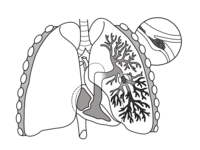
Photo from wikipedia
Introduction: With the recent advancement, there are still large number of stroke patients who end up with poor outcome despite getting thrombectomy. Clot extent, location, and collateral integrity are found… Click to show full abstract
Introduction: With the recent advancement, there are still large number of stroke patients who end up with poor outcome despite getting thrombectomy. Clot extent, location, and collateral integrity are found to be important determinants of outcome in acute stroke. The CBS is a scoring system (0-10) to define the extent of thrombus on CTA. The collateral grading system is scored on a scale of 0-3 on CTA. The purpose of this study is to compare the relationship of clot extent and collaterals with clinical and radiological outcome. Hypothesis: A novel clot burden score (CBS) and collateral score (CS) are important determinants of outcomes and serve as useful additional stroke outcome predictors. Methods: One hundred and twenty eight stroke patients with large vessel occlusion who underwent endovascular thrombectomy in our institution were reviewed retrospectively. CBS and CS were calculated on CTA by a neuroradiologist and a vascular neurologist and reached a consensus who were blinded about clinical information. Patients were dichotomized using collateral scores as good (>/=2) vs bad collaterals (0-1). Univariate and multivariate analysis is performed. Results: A total of 128 patients included in the study. Poor collateral is found to be associated with prior history of Afib (47% vs 32%) whereas smoking is found to be associated with good collaterals (38% vs 29%). Low CBS (higher clot burden) is associated more with poor collaterals (70% vs 46%). Poor collateral is associated with higher inhouse mortality (23% vs 9%) and increase number of patients with mRS of 5-6 at 3 months (42% vs 21%). Revascularization rate TICI 2b-3 is not found to be significantly associated with the degree of collaterals (93% with good collaterals whereas 78% in poor collaterals) Conclusions: CBS and CS are useful additional markers predicting clinical and radiologic outcomes and could be potentially used clinically as an adjunct to other imaging and clinical features to stratify patient risk better.
Journal Title: Stroke
Year Published: 2021
Link to full text (if available)
Share on Social Media: Sign Up to like & get
recommendations!